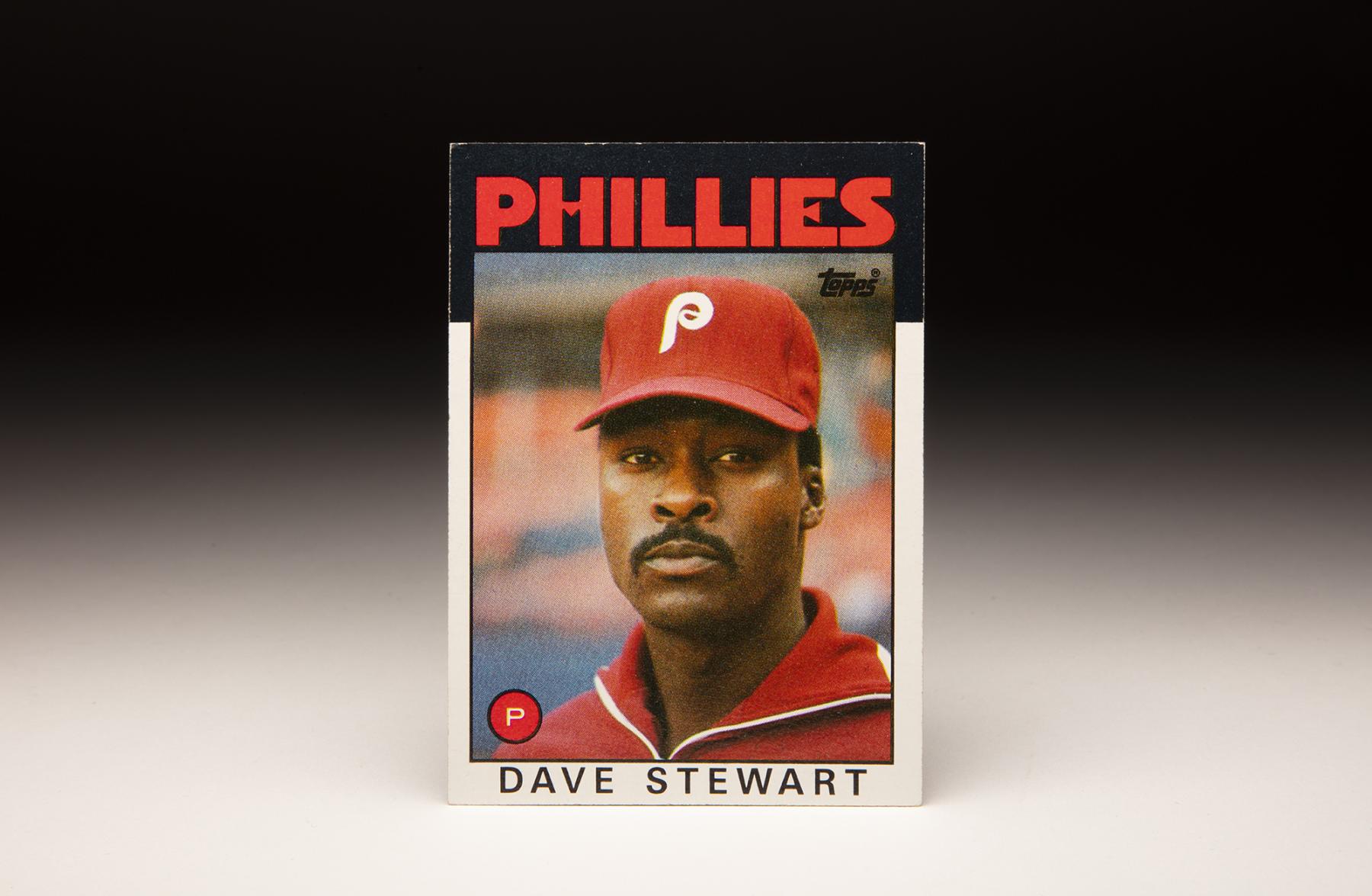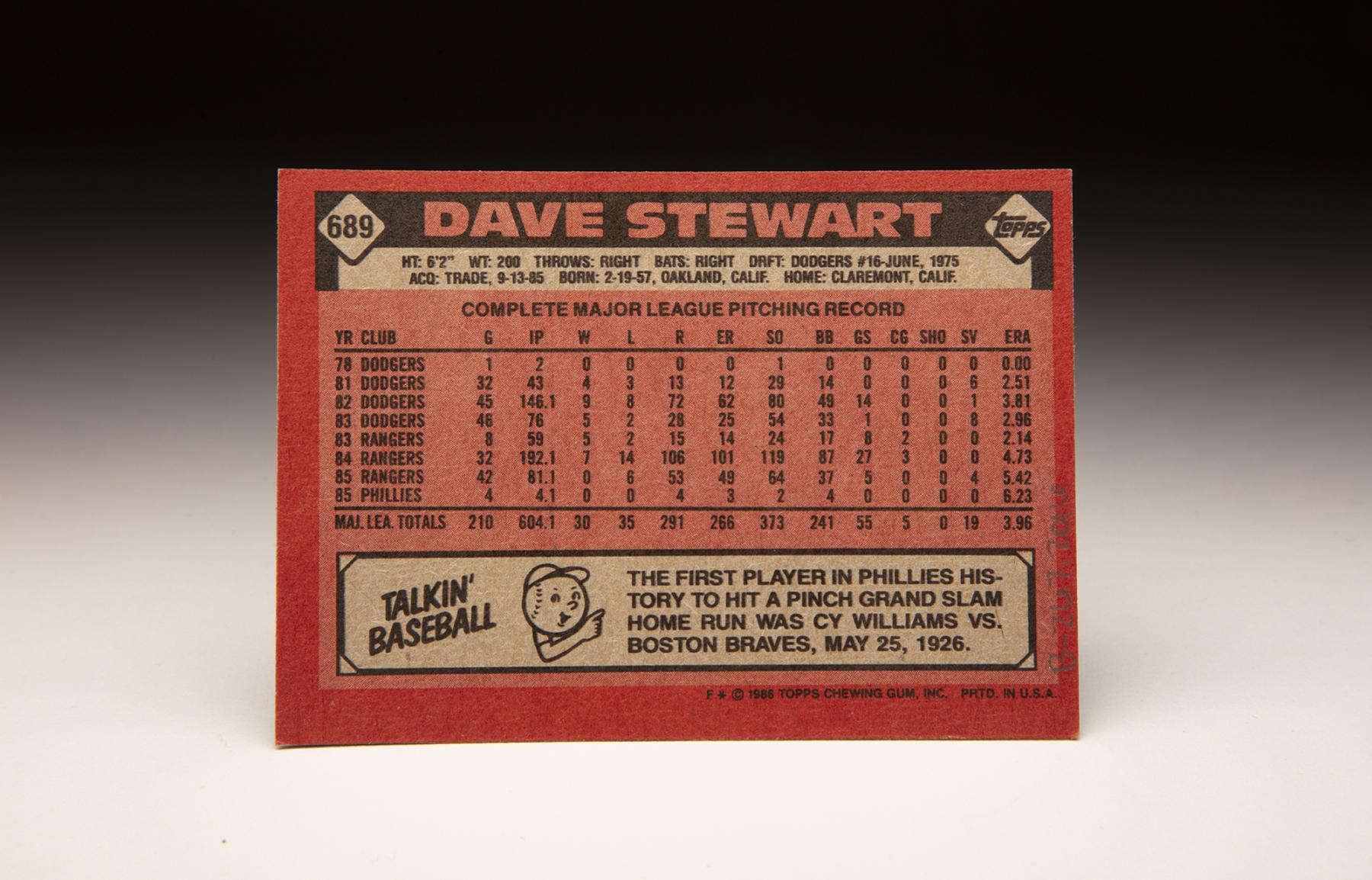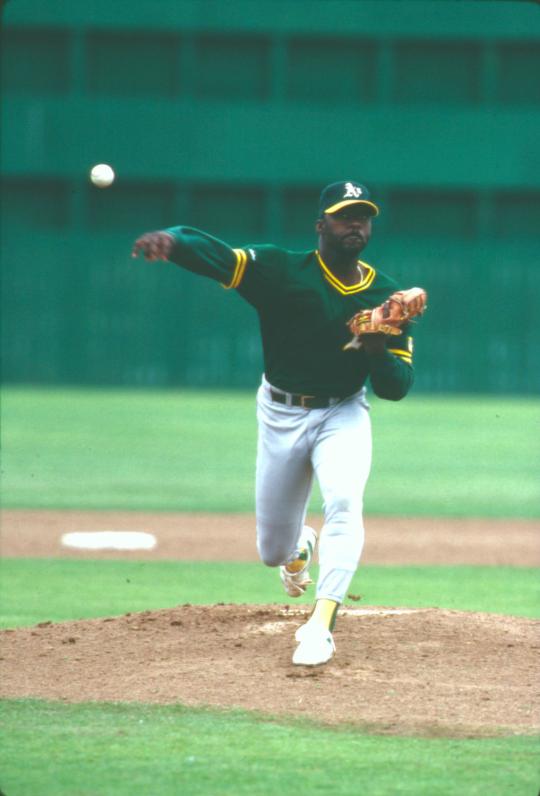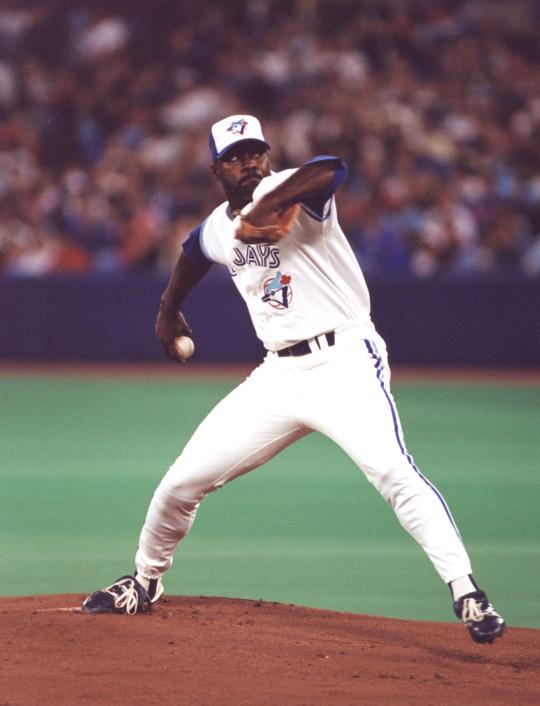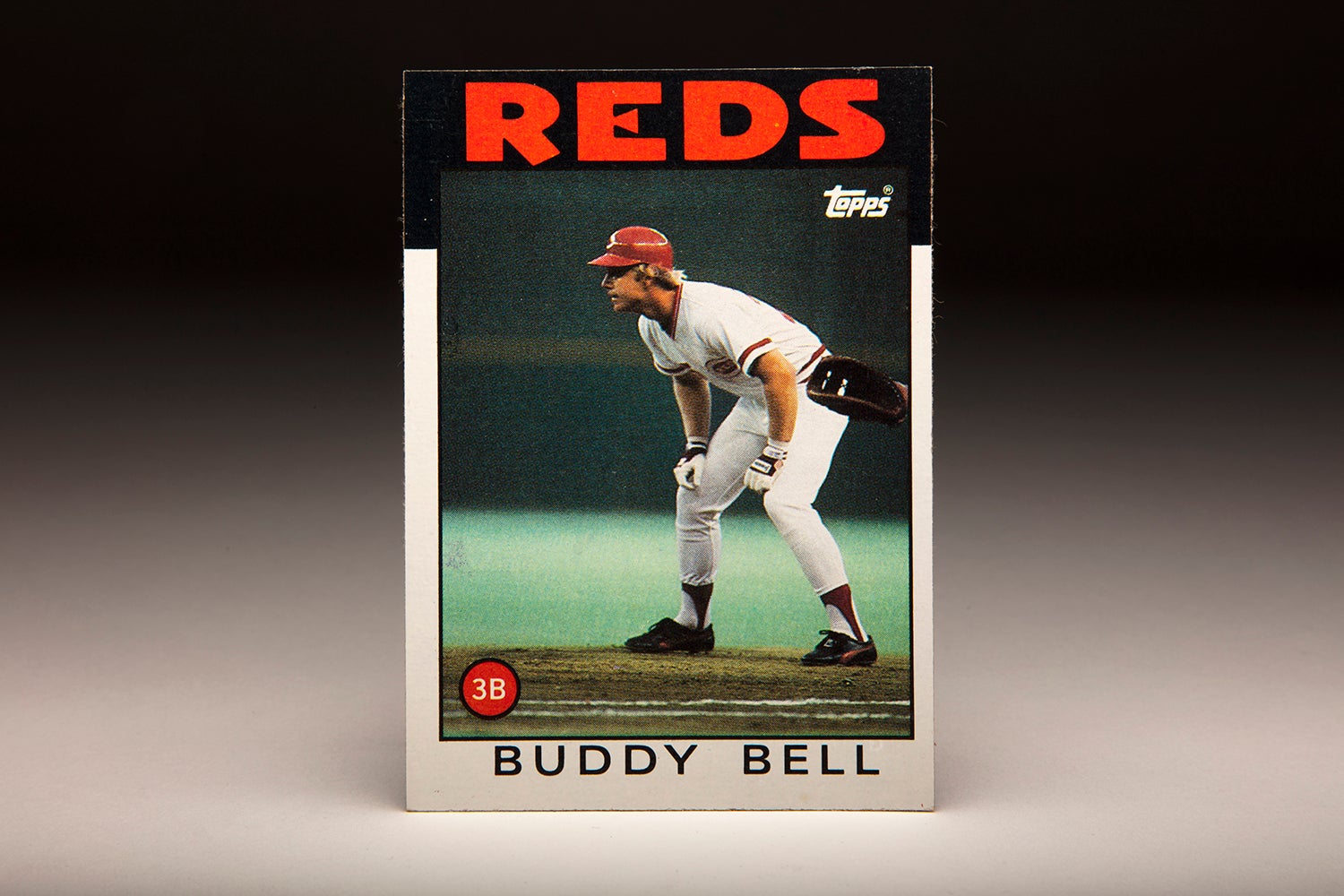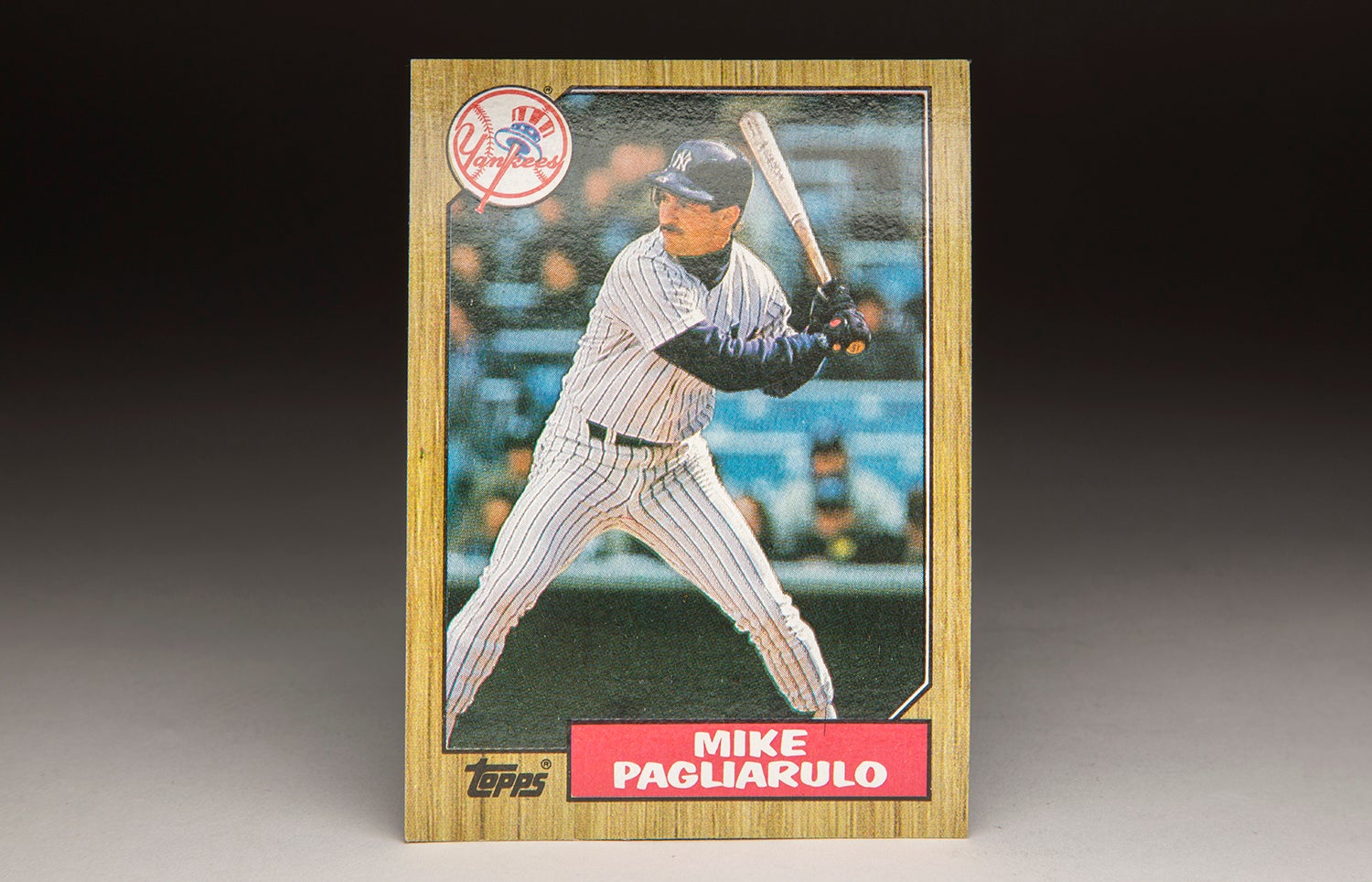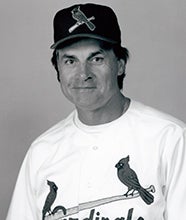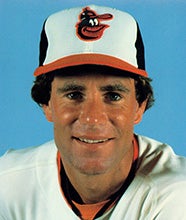- Home
- Our Stories
- #CardCorner: 1986 Topps Dave Stewart
#CardCorner: 1986 Topps Dave Stewart
He stood on the pitcher’s mound with his cap pulled down nearly to his eyebrows, glaring at the best hitters his generation had to offer.
And Dave Stewart never blinked. For a slice of time in the late 1980s and early 1990s, the Oakland A’s ace was baseball's most celebrated big game pitcher.
Athletics Gear
Represent the all-time greats and know your purchase plays a part in preserving baseball history.
But to reach that pinnacle, Stewart endured a decade of challenges.
Stewart was born Feb. 19, 1957, in Oakland, Calif. A three-sport star in high school, Stewart turned down numerous college scholarship offers to sign with the Dodgers after Los Angeles took him in the 16th round of the 1975 MLB Draft.
A catcher as an amateur player, Stewart was converted to a pitcher by the Dodgers and sent to Bellingham of the Class A Northwest League, where he was 0-5 with a 5.51 ERA in 22 games in 1975. But the Dodgers loved his live arm and promoted Stewart to Danville of the Midwest League in 1976 despite going 1-1 with a 5.04 ERA with Bellingham in the first half of the 1976 season. He was 0-2 with a 16.20 ERA in four games with Danville, but returned to the Midwest League in 1977 with Clinton – where he was 17-4 with a 2.15 ERA and 144 strikeouts in 176 innings.
The Dodgers gave Stewart a start for Triple-A Albuquerque at the end of the 1977 season, then sent him to Double-A San Antonio in 1978 – where Stewart was 14-12 with a 3.68 ERA. He made his big league debut for the Dodgers on Sept. 22, 1978, pitching two innings of scoreless relief against the Padres.
Stewart spent the next two seasons in the high-scoring Pacific Coast League with Albuquerque, winning a combined 26 games. But the Los Angeles front office was not yet sold on Stewart, and in the spring of 1981 – with Stewart out of minor league options – the Dodgers faced a decision.
Following the 1979 season, Los Angeles signed relief pitcher Don Stanhouse to a five-year, $2.1 million contract. But Stanhouse struggled in 1980 and was hobbled in Spring Training of 1981 by a chronic back problem. With one spot left in the bullpen, the Dodgers – on the last day of Spring Training – told Stewart that he would not make the club. But they immediately asked Stewart to stay in the clubhouse for the time being.
“A dream was being taken away from me,” said Stewart, who broke down in tears after being told he was headed back to the minors.
Faced with the real possibility that Stewart would be claimed by another team on waivers, the Dodgers backtracked – and decided to release Stanhouse and pay him the $1.36 million they still owed him. And Stewart made the team.
Aside from one appearance with Triple-A Tacoma in 1986, Stewart would never again pitch in the minors.
Dodgers manager Tommy Lasorda used Stewart out of the bullpen in 1981, and Stewart did not allow a run in his first 10 appearances.
“After Dave Stewart faced the Phillies (May 18, striking out three over two perfect innings), when I went home, my wife, Jo, looked at me and said ‘A star is born,’” Lasorda told the Dayton Daily News.
Stewart finished the season with a 4-3 record, six saves and a 2.49 ERA in 32 games. He lost two games in the NLDS vs. the Astros, but the Dodgers won the series – and then defeated the Expos in the NLCS to advance to the Fall Classic. Stewart made two scoreless appearances against the Yankees in the World Series to help Los Angeles win the title.
With his path seemingly headed toward fame, Stewart embarked on a five-year odyssey that nearly ended his career. After struggling out of the bullpen early in the 1982 season, Stewart was used as a spot starter and finished with a 9-8 record with a 3.81 ERA in 146.1 innings.
“It was really, really, really bad,” Stewart told the Fort Worth Star-Telegram in 1984. “Every time I’d go into a game, I’d be booed in L.A.”
The Dodgers returned Stewart to the bullpen the next season, where he was 5-2 with eight saves and a 2.96 ERA in 46 games. But on Aug. 19, the Dodgers sent Stewart, Ricky Wright and $200,000 to the Rangers in exchange for Rick Honeycutt, who would win the AL ERA title that year and was one of the most coveted players available that summer.
Honeycutt went 2-3 with a 5.77 ERA for Los Angeles, but the Dodgers won the NL West title. Stewart, meanwhile, was moved to the Rangers’ rotation and went 5-2 with a 2.14 ERA in eight starts for Texas.
“I’m just glad I’m getting a chance to pitch,” Stewart told the Star-Telegram, “a chance to come to a club that is developing and pitch every fifth day.”
But 1984 proved to be a disaster. The Rangers went 69-92 and finished last in the AL West, while Stewart was 7-14 with a 4.73 ERA in 192.1 innings. He returned to the bullpen in 1985, going 0-6 with a 5.42 ERA in 42 games before being traded to the Phillies on Sept. 13 for Rich Surhoff.
After eight relief appearances and a 6.57 ERA in 1986 and undergoing surgery to remove bone chips from his right elbow after the season, the Phillies released Stewart on May 9. Two weeks later, the A’s signed Stewart to a minor league deal and sent him to Tacoma.
After his one appearance in Triple-A, Stewart was summoned home to Oakland. And by the beginning of August, he had claimed a spot in the A’s rotation and won nine of his first 10 decisions before tiring down the stretch to finish 9-5 with a 3.74 ERA.
Ten months later, Stewart was the talk of baseball en route to an MLB-leading 20 victories.
“I’m not surprised at my success,” Stewart told the Philadelphia Inquirer. “The only difference was that Oakland gave me an opportunity to pitch.”
Using a darting forkball to compliment a fastball that earned him the nickname “Smoke,” Stewart finished the 1987 season 20-13 with a 3.68 ERA and 205 strikeouts in 261.1 innings. He finished third in the AL Cy Young Award voting, the first of four straight seasons where Stewart finished in the Top 4.
“Dave is definitely a guy the other players have a real good feeling for,” said Athletics manager Tony La Russa, “because they know that he’s always going to be mentally ready to go out there.”
La Russa and the Athletics put everything together in 1988, winning the AL West title and advancing to the World Series against the Dodgers.
Stewart was 21-12 with an AL-best 14 complete games and an MLB-leading 275.2 innings. No pitcher was worked more innings in one season since.
Stewart made his first postseason appearance in seven seasons in Game 1 of the ALCS vs. Boston, and also started Game 1 of the World Series.
He was in line for a World Series win – allowing three runs over eight innings – before Kirk Gibson’s pinch-hit home run off Dennis Eckersley gave the Dodgers a 5-4 victory and propelled them to the title.
In 1989, Stewart and the A’s made it all the way to the top. Stewart was 21-9 and finished second in the Cy Young Award race, while the A’s defeated the Blue Jays in the ALCS and the Giants in the World Series. Stewart was named the MVP of the Fall Classic after going 2-0 with a 1.69 ERA in the Athletics’ four-game sweep. He was named to his first and only All-Star Game that season.
In 1990, the 33-year-old Stewart posted his fourth straight 20-win campaign, the most since Jim Palmer posted four such seasons from 1975-78. He threw a no-hitter against the Blue Jays on June 29, then started Game 1 of the ALCS (later winning series MVP honors) and Game 1 of the World Series. But the Reds denied the Athletics their repeat by sweeping Oakland.
The innings workload – an average of 265 from 1987-90 – began to take its toll in 1991 as Stewart went 11-11 with a 5.18 ERA. He bounced back to go 12-10 with a 3.66 ERA in 1992 as the A’s won their fourth AL West title in five years, but Toronto won the ALCS despite Stewart’s 1-0 record and 2.70 ERA in the series.
Following the season, Stewart signed a two-year, $8.5 million contract with the Blue Jays.
“The key issue was not money,” Stewart’s agent, Tony Attanasio, told the Associated Press. “The important issue was the aggressiveness of the organization.”
The Blue Jays, who had won their first World Series title in 1992, prized Stewart’s competitiveness as they set their sights on back-to-back crowns. Stewart posted a 12-8 record with a 4.44 ERA in 26 starts, helping Toronto return to the World Series when he went 2-0 with a 2.03 ERA in the ALCS vs. the White Sox, again earning ALCS MVP honors. Stewart was 0-1 in two starts in the World Series, but the Blue Jays repeated as champions by defeating the Phillies in six games.
Stewart’s second season in Toronto was less successful, as he went 7-8 with a 5.87 ERA. He returned to Oakland in 1995, going 3-7 in 16 starts before ending his career when he announced his retirement on July 24.
Stewart quickly began work with big league front offices and coaching staffs, serving as a pitching coach for the Padres, Blue Jays and Brewers while interviewing for administrative jobs. He then started his own sports agency where he represented players like Matt Kemp before becoming the Diamondbacks general manager in 2014.
Renowned for his work with charities and community organizations, Stewart won the Roberto Clemente Award in 1990.
For a player whose talent seemed to be dwarfed only by his work ethic, Stewart’s greatest legacy may have been his unflagging belief in himself.
Craig Muder is the director of communications for the National Baseball Hall of Fame and Museum

